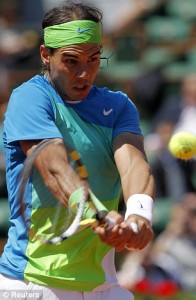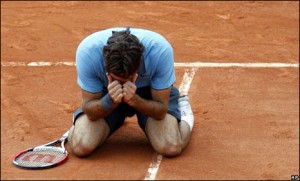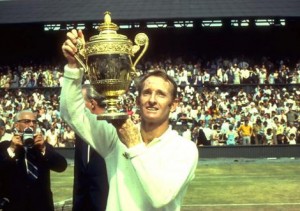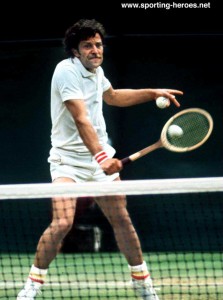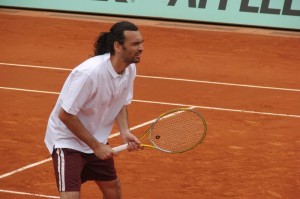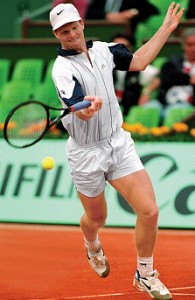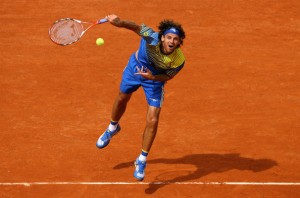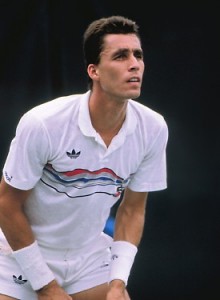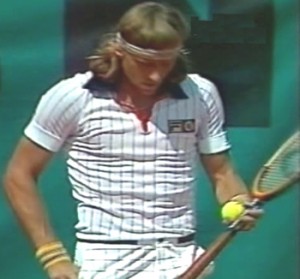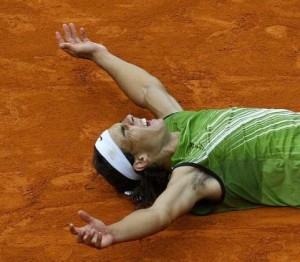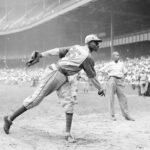French Open Champions: Best 8 in the Modern Era
More than any of the other majors, the French Open often produces a special kind of champion who loves to burrow down and blast his way through the red clay.
What is more, today, these French Open supernovas often manage to translate the skills that allow them to win on clay to other surfaces.
Winning on clay demands players excel in developing points using the brain as well as brawn—utilizing defensive skills, often as the launching pad for offense. The clay-court match requires playing with a huge measure of patience—hence, the phrase grinding it out becomes relevant in tennis.
Many professionals point to the lack of clay courts in the United States as one of the reasons for the reported failure of U.S. tennis during the past two decades.
The number of clay courts in the United States has dwindled dramatically. Today’s American youngsters learn to play almost exclusively on hard courts, foregoing the lessons imparted to their European and South American counterparts on homeland clay courts.
Of course, grass and clay courts are far more expensive to maintain which explains why these special surfaces are dying out in most places.
When you look at the ATP calendar, the clay court season lasts approximately two months—from April to the first week in June.
The grass season is even shorter—one month. The rest of the calendar is played on artificial surfaces of various textures and rebound strength.
The French Open has been played since 1891. Starting in 1928, the tournament was played on the red clay courts of Stade Roland Garros in Paris.
Naturally, no tennis aficionado can talk about the greats of tennis history without mentioning the great Four Musketeers of French tennis: Jean Borotra, Jacques Brugnon, Henri Cochet and René Lacoste who were responsible for the great enthusiasm the French have for tennis.
Since the modern era began in 1968, however, there have been only a handful of multiple winners of the French Open. The top eight French Open Champions of the Open Era have won the title more than once since 1968.
If titles are equal, then the number of finals reached is considered. If all else is equal, the winning percentage becomes the final determining factor.
Honorable Mention No. 2: Roger Federer of Switzerland
Appeared in five finals, four consecutive from 2006-2009, winning one title in 2009.
Unfortunately for the infinitely talented Mr. Federer, the Swiss met Rafael Nadal in every French Open final in which he competed—except in 2009 when Federer won the French Open title for the first and only time in his career.
That year Federer defeated Robin Soderling in the final—the same Robin Soderling who had ousted Nadal unceremoniously in the fourth round.
The win in Paris gave Federer his career grand slam, having been denied the French Open crown for three consecutive years.
When Federer made the final again in 2011, many thought the quality of his play should have given him a second title, but a stubborn Nadal came back to win in four sets.
If Federer were to win the title for a second time, he would advance into the top nine champions of French Open in the Open Era.
Currently Federer has an 80.33 winning percentage at the French Open with room to improve and time to advance.
Honorable Mention No. 1: Rod Laver of Australia
Appeared in three French Open finals, winning two but only one in the Open Era.
When former world No. 1 Rod Laver pulled out all the stops to win on clay, he did so in splendid fashion.
In 1962 and 1969, years when Laver took home French Open championships, the Aussie also won calendar year slams—seizing all four of the majors in the same year.
No man has done it since.
Therefore, even though Laver did not win both his French Open titles during the years since 1968, his two wins on the clay cannot be overlooked when considering the best ever French Open champions.
In 1969, Laver defeated fellow Australian Ken Rosewall 6-4, 6-3, 6-4 to take home the crown from Roland Garros.
Laver compiled an 80.65 winning percentage during his eight appearances at the French Open throughout his career.
8. Jan Kodes of Czechoslovakia
Appeared in two French Open finals, winning both.
Jan Kodes, born March 1, 1946, in Prague, Czechoslovakia, made a name for himself in the early 1970s by winning three grand slam tournaments, two of them on the courts of Stade Roland Garros.
In 1973 Kodes won the Wimbledon championship at the All-England Club defeating Alex Metreveli 6-1, 9-8, 6-3—despite the Czech’s disdain for grass.
Kodes also reached the finals at the U.S. Open in 1971 and 1973, but came up short on both occasions.
The Czech’s greatest successes, however, came on the clay courts at the French Open in Paris. He won the title there in 1970, beating Zelijko Franulovic in the final 6-2, 6-4, 6-0.
The following year in 1971, Kodes defeated Ilie Nastase in a hard-fought final 8-6, 6-2, 2-6, 7-5.
Kodes reached his highest tour ranking of world No. 4 in September 1973.
During his career he won a total of eight top-level singles titles and 17 doubles titles, but the red clay remained his favorite surface.
7. Sergi Bruguera of Spain
Appeared in three French Open finals, winning twice.
Spaniard Sergi Bruguera was a clay court specialist back in the days when there were such players who produced their best play on the red dirt, avoiding other surfaces like the plague.
Today, of course, the clay-courters simply use their surface of choice to launch an almost as equally successful all-court game.
Bruguera won consecutive titles on the grounds at Stade Roland Garros in 1993 and 1994.
Making his first grand slam final in 1993, the Spaniard defeated American and defending French Open champion Jim Courier 6-4, 2-6, 6-2, 3-6, 6-3.
The following year, in 1994, Bruguera won over fellow Spaniard Alberto Berasategui 6-3, 7-5, 2-6, 6-1.
Bruguera appeared in one more French Open final in 1997, losing in straight sets 6-3, 6-4, 6-2 to Brazilian Gustavo Kuerten.
Brugera’s overall winning percentage for the French Open reached 76.19.
6. Jim Courier of the United States
Appeared in three French Open, winning twice.
American Jim Courier seemed to embrace the red clay, making it his own—a rarity for U.S. tennis players who long complained about the complexity of winning at Stade Roland Garros.
Courier won four grand slams throughout his career––two Australian Open and two French Open titles.
He also became the first American to be ranked world No. 1 since John McEnroe back in the mid-1980s.
As improbable as it seemed to the world, Courier won the French Open Championship twice in back-to-back years, 1991 and 1992.
In 1991, Courier defeated fellow American Andre Agassi in a five set final 3-6, 6-4, 2-6, 6-1, 6-4. It marked Courier’s first grand slam win.
In 1992, Courier defeated Czech Petr Korda in the final 7-5, 6-2, 6-1.
Courier made the final once again in 1993, losing to Spaniard Sergi Bruguera in a grueling five set final 6-4, 2-6, 6-2, 3-6, 6-3.
After that 1993 defeat in Paris, Courier was never able to make it back to a French Open final.
Courier’s overall winning percentage at the French Open remains at 81.63.
5. Gustavo Kuerten of Brazil
Appeared in three French Open titles, winning all three.
Gustavo Kuerten remains, perhaps, one of the most beloved former world No. 1 players in the history of tennis. His infectious smile and his love of the game won the Brazilian many followers.
He won three grand slam finals throughout his career—all on the red clay of Stade Roland Garros.
Keurten’s first championship in Paris came against Spaniard Sergi Bruguera 6-3, 6-4, 6-2 in 1997.
Later, the Brazilian would win back-to-back French Open titles in 2000-2001.
Kuerten defeated Swede Magnus Norman in 2000, 6-2, 6-3, 2-6, 7-6.
The former world No. 1 repeated the feat in 2001, defeating Spaniard Alex Corretja in the final on the grounds of Stade Roland Garros, 6-7, 7-5, 6-2, 6-0.
Suffering numerous injuries throughout his career, Kuerten’s play on clay was regarded as brilliant, but his success was ultimately short lived.
Kuerten’s overall winning percentage for his French Open appearances remains at 81.8.
4. Ivan Lendl of Czechoslovakia
Appeared in five French Open finals, winning three.
Ivan Lendl finally won his first grand slam title in 1984 by defeating American John McEnroe in the finals of the French Open after losing the first two sets.
Lendl came away with the victory over McEnroe, winning 3-6, 2-6, 6-4, 7-5, 7-5.
The 1984 upset of McEnroe during the French Open final marked the beginning of eight grand slam wins for Lendl, with three of them coming on the grounds of Stade Roland Garros.
After his win in 1984, Lendl went on to win the French Open title again in 1986 by defeating Swede Mikael Pernfors in the final 6-3, 6-2, 6-4.
He triumphed again in 1987 by overcoming Swede Mats Wilander 7-5, 6-2, 3-6, 7-6 for the French Open championship.
Lendl came in as runner-up to Swede Bjorn Borg in 1981. It marked Borg’s last victorious French Open final.
The Czech was also the runner-up to Mats Wilander in 1985 losing 3-6, 6-4, 6-2, 6-2.
Lendl’s overall winning percentage at the French Open stands at 81.5.
3. Mats Wilander of Sweden
Appeared in five French Open finals, winning three.
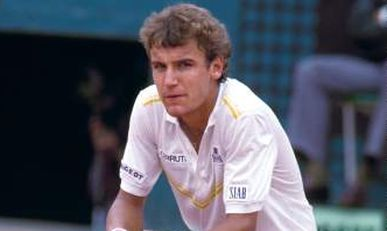 Swede Mats Wilander won the French Open three times in 1982, 1985 and 1988.
Swede Mats Wilander won the French Open three times in 1982, 1985 and 1988.
In 1982, Wilander surprised the tennis world by coming through unseeded as a 17-year-old teenager to defeat Argentine Guillermo Vilas in the final 1-6, 7-6, 6-0, 6-4.
The young Swede was immediately heralded as the next coming of Borg, who had retired abruptly after winning the French Open title in 1981—but losing to John McEnroe in London and New York City.
In 1985, Wilander managed to upset Ivan Lendl, the defending champion, in the final of the French Open winning 3-6, 6-4, 7-6, 6-2.
Then again in 1988, Wilander met and defeated Frenchman Henri Leconte 7-5, 6-2, 6-1 to capture the French Open crown.
Additionally, Wilander made the French Open final in 1983, losing to Frenchman Yannick Noah 6-2, 7-5, 7-6 and again in 1987, losing to Ivan Lendl 7-5, 6-2, 3-6, 7-6.
Mats Wilander’s overall winning percentage at the French Open peaked at 83.9.
2. Bjorn Borg of Sweden
Appeared in six French Open finals, winning six titles.
Bjorn Borg won his first French Open Championship in 1974 on the grounds of Stade Roland Garros, where he met and defeated Manuel Orantes 2-6, 6-7, 6-0, 6-1, 6-1.
The Swede followed that up by winning the title the following year over Argentine Guillermo Vilas 6-2, 6-3, 6-4.
After a brief absence, Borg came back to win the French Open title in 1978, once again over Vilas 6-1, 6-1, 6-3.
The Swede won the 1979 French Open title the following year by defeating Victor Pecci of Paraguay 6-3, 6-1, 6-7, 6-4.
In 1980, Borg triumphed again on the red dirt in Paris, defeating American Vitas Gerulaitis 6-4, 6-1, 6-2.
Defeating Ivan Lendl in 1981, 6-1, 4-6, 6-2, 3-6, 6-1, Borg won his final French Open championship.
The remarkable Swede won every French Open final he reached.
The only man to defeat Borg on the clay courts of Paris was Adriano Panatta who won the French Open in 1976, defeating Borg in the quarterfinals. Panatta also defeated Borg in the fourth round of the French Open in 1973.
Borg’s overall winning percentage at the French Open championships is a whopping 96.08.
1. Rafael Nadal of Spain
Appeared in six French Open finals with six wins.
When you think of the French Open, you automatically think of Rafael Nadal, who may be the best man ever to wield a racket on the courts of Stade Roland Garros.
As it stands, Nadal is the only active player on our list. That means, in subsequent years, he is capable of distancing himself even more from the rest of the mere mortals playing tennis on clay.
To date, Nadal has won six French Open titles, beginning in 2005 when he won the title over Mariano Puerta on his first try in Paris.
In 2006, Nadal met world No. 1 Roger Federer in the French Open final, defeating the Swiss 1-6, 6-1, 6-4, 7-6.
Unfortunately for Federer, who many argue was a brilliant player on clay, his reign happened to coincide with that of Nadal’s. On clay, it seemed Nadal could not be beaten.
The following year in 2007, Federer and Nadal again met in the French Open final with the Majorcan winning 6-3, 4-6, 6-3, 6-4.
Nadal won his fourth consecutive French Open final in 2008 by dismissing the Swiss in straight sets 6-1, 6-3, 6-0––the worst defeat in a grand slam final in Federer’s long, distinguished career.
Nadal, however, was dismissed in the fourth round of the French Open in 2009 by Swede Robin Soderling. It remains Nadal’s first and only loss on the red clay of Stade Roland Garros.
But Nadal came back to win the French Open title in 2010 by defeating Soderling in the final 6-3, 7-5, 6-4.
In 2011, Nadal’s opponent would once again be his old nemesis, Roger Federer. Even though the contest was close throughout, Nadal would win 7-5, 7-6, 5-7, 6-1.
Nadal’s overall winning percentage at the French Open is 97.83––the highest to date.
Should Nadal win the title in 2012, giving him a seven French Open championships, he would finally take that one step ahead of Bjorn Borg, who was so long considered the best clay court player of all time.
